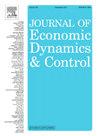The credit card and small business lending channels of monetary policy
IF 2.3
3区 经济学
Q2 ECONOMICS
引用次数: 0
Abstract
This paper analyzes the lending channel of monetary policy exclusively through credit card and small business bank loans. A time-varying parameter vector autoregression is estimated, providing evidence that the direction and strength in which credit card and small business loans respond to monetary policy are time-dependent. To investigate these findings analytically, I develop a general equilibrium model of consumer credit card and small business lending. Households and firms use a combination of monetary assets and bank loans to finance random consumption and investment opportunities. In accordance with conventional theory, when borrowers are sufficiently constrained, a monetary tightening reduces lending through the balance sheet subchannel of monetary policy. However, when borrowers are less constrained, a monetary tightening raises unsecured debt limits through a second subchannel and lending expands. This second subchannel, operating solely through unsecured credit, offers a new theory to justify an expansionary loan response to tightened monetary policy that the traditional lending channel literature has yet to address.
信用卡和小企业贷款渠道的货币政策
本文专门分析了货币政策的借贷渠道,即信用卡和小企业银行贷款。估计了一个时变参数向量自回归,提供了信用卡和小企业贷款对货币政策响应的方向和强度是时变的证据。为了分析这些发现,我开发了一个消费者信用卡和小企业贷款的一般均衡模型。家庭和企业将货币资产和银行贷款结合起来,为随机消费和投资机会提供资金。根据传统理论,当借款人受到充分约束时,货币紧缩会通过货币政策的资产负债表子渠道减少放贷。然而,当借款人受到的约束减少时,货币紧缩会通过第二个子渠道提高无担保债务上限,从而扩大贷款规模。第二个子渠道仅通过无担保信贷运作,它提供了一种新的理论,为应对货币政策收紧的扩张性贷款提供了理由,这是传统贷款渠道文献尚未解决的问题。
本文章由计算机程序翻译,如有差异,请以英文原文为准。
求助全文
约1分钟内获得全文
求助全文
来源期刊

Journal of Economic Dynamics & Control
ECONOMICS-
CiteScore
3.10
自引率
10.50%
发文量
199
期刊介绍:
The journal provides an outlet for publication of research concerning all theoretical and empirical aspects of economic dynamics and control as well as the development and use of computational methods in economics and finance. Contributions regarding computational methods may include, but are not restricted to, artificial intelligence, databases, decision support systems, genetic algorithms, modelling languages, neural networks, numerical algorithms for optimization, control and equilibria, parallel computing and qualitative reasoning.
 求助内容:
求助内容: 应助结果提醒方式:
应助结果提醒方式:


